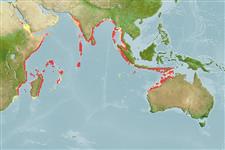Common names from other countries
Environment: milieu / climate zone / depth range / distribution range
বাস্তুসংস্থান
সামুদ্রিক; স্বাদু পানি; ঈষৎ লোনা সমুদতলে ভাসমান বেনথোপেলাজিক; ক্যাটাড্রমাস (Ref. 51243). Tropical; 23°N - 33°S
Asia: Pakistan, India, Sri Lanka, Burma, and the East Indies. Reported from Nepal (Ref. 9496, 12045) and Bangladesh (Ref. 1479).
আকৃতি / ওজন / Age
Maturity: Lm ? range ? - ? cm
Max length : 200 cm TL পুরুষ/ লিঙ্গ অনিধর্ারিত ; (Ref. 85009); common length : 80.0 cm TL পুরুষ/ লিঙ্গ অনিধর্ারিত ; (Ref. 4832); সবের্াচ্চ প্রকাশিত ওজন : 6.0 kg (Ref. 1479)
পৃষ্ঠীয় নরম পাখনা দন্ড (মোট ) : 250 - 305; পায়ূর নরম পাখনা্তুন্ড: 220 - 250; কশেরুকা : 106 - 112. Body elongate, head conical, flattened dorsally. Mouth terminal, lips prominent, narrow bands of teeth on jaws, broad band on vomer.
Lives in freshwaters, but also occurs in estuaries and in the sea during early life and near maturity (Ref. 4832). Occurs in freshwater streams, pools and reservoirs and commonly found in mud substrates of tanks and in deep rock pools of rivers (Ref. 41236). Most common eel in Indian inland waters. There exists a good export market for both live elvers and eels. Highly prized as food fish because of its nutritional value. Fish mucous from live fish mixed with rice or wheat flour is used as medicine for arthritis (Ref. 44150).
Life cycle and mating behavior
Maturities | প্রজনন | Spawnings | Egg(s) | Fecundities | শুককীট
Talwar, P.K. and A.G. Jhingran, 1991. Inland fishes of India and adjacent countries. vol 1. A.A. Balkema, Rotterdam. i-liv + 1-541, 1 map (Ref. 4832)
IUCN Red List Status (Ref. 130435)
CITES (Ref. 128078)
Not Evaluated
Threat to humans
Harmless
Human uses
মৎস্য: বাণিজ্যিক; এ্যাকুয়াকালচার (জলজ পালন) : সম্ভাব্য ভবিষ্যত ব্যবহার ; শিকারযোগ্য মাছ: হঁ্যা
হাতিয়ার
Special reports
Download XML
ইন্টারনেট সুত্র
Estimates based on models
Preferred temperature (Ref.
115969): 26.2 - 29.3, mean 28.3 (based on 292 cells).
Phylogenetic diversity index (Ref.
82804): PD
50 = 0.5000 [Uniqueness, from 0.5 = low to 2.0 = high].
Bayesian length-weight: a=0.00076 (0.00037 - 0.00155), b=3.17 (3.00 - 3.34), in cm Total Length, based on LWR estimates for this Genus-body shape (Ref.
93245).
ট্রফিক পর্যায়ে (Ref.
69278): 3.8 ±0.7 se; based on size and trophs of closest relatives
স্থিতিস্থাপক (Ref.
120179): অত্যন্ত কম , সর্বনিম্ন প্রজন দ্বিগুনের সময় ১৪ বৎসর (Preliminary K or Fecundity.).
Fishing Vulnerability (Ref.
59153): Very high vulnerability (90 of 100).
